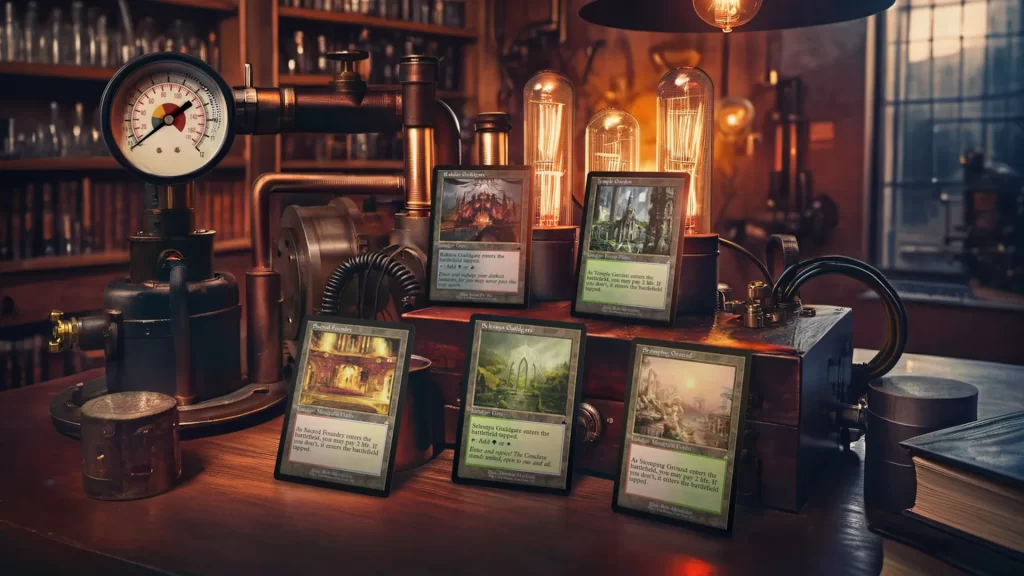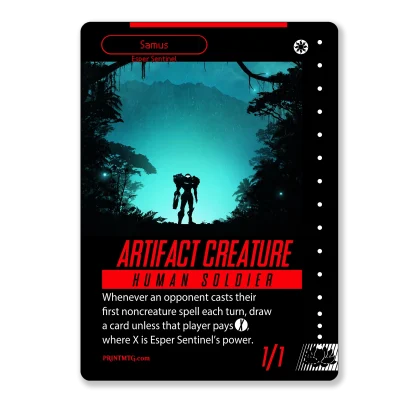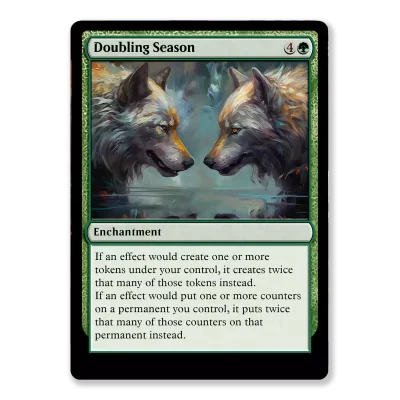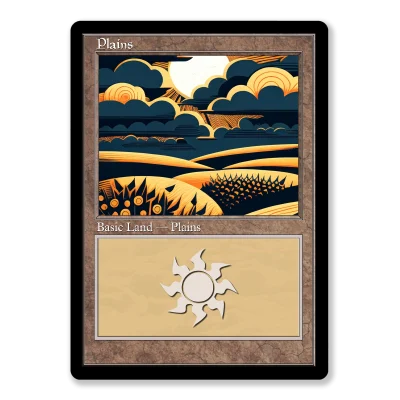Wizards of the Coast can’t seem to get through January without courting disaster. Exactly one year after the OGL controversy began, the company responsible for both Dungeons & Dragons and Magic: The Gathering has mishandled a case of AI-generated art in a series of advertising images posted online over the weekend.
In several now-deleted posts on January 4th, Wizards of the Coast promoted reprints of popular land cards in a retro-style frame with quotes like “It’s positively shocking how good these lands look in a retro frame.” The backgrounds resembled 1800s laboratories, reminiscent of Mary Shelley’s Frankenstein or more reserved steampunk fiction. Another set of images showcasing popular reprints from the plane of Ravnica featured an academic tower in a sprawling high-fantasy city.
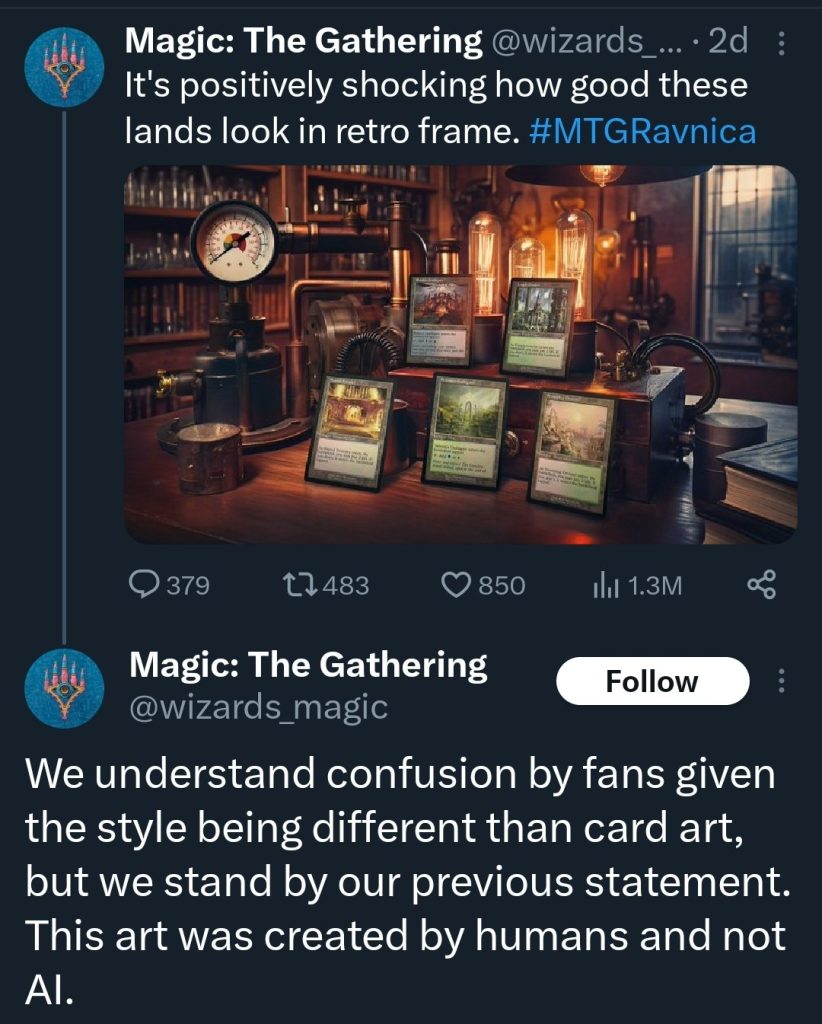
Sharp-eyed online sleuths quickly identified several details in the backgrounds of these posts that appeared distorted, warped, or garbled, hinting at some AI-generated involvement. The volume of complaints and criticisms reached a point where Wizards of the Coast felt compelled to comment. A now-deleted post stated, “We understand the confusion among fans due to the different style compared to card art, but we stand by our previous statement. This art was created by humans and not AI.”
Despite the firm denial, individuals continued to point out discrepancies, such as a steam gauge with numbers that made no sense, a tangled mess of wires with no clear path, and details that mysteriously faded away. For two days, accusations persisted, growing in intensity and puzzlement as Wizards of the Coast remained oddly silent on the matter. On January 6th, prolific illustrator and webcomic artist Dave Rapoza announced that he would no longer collaborate with Magic: The Gathering.
“And just like that, poof, I’m done working for Wizards of the Coast – you can’t claim to stand against this and then blatantly use AI to promote your products. Emails sent, goodbye to all of you!” Rapoza tweeted on January 6th. “If you’re going to take a stand, make sure you’re actually paying attention. Don’t be lazy, and don’t lie.”
Rapoza’s comments alluded to Wizards of the Coast’s supposed stance against using AI in their products, which they published on the MTG mothership on December 19th, explicitly stating that the company “[requires] artists, writers, and creatives contributing to the Magic TCG to refrain from using AI generative tools to create final Magic products.”
Well, we made a mistake earlier when we said that a marketing image we posted was not created using AI. Read on for more. (1/5)
— Magic: The Gathering (@wizards_magic) January 7, 2024
Wizards finally responded on January 7th and, to the surprise of many, admitted that the images indeed contained numerous AI-generated elements: “Well, we made a mistake earlier when we said that a marketing image we posted was not created using AI. As you, our diligent community, pointed out, it seems that some AI components, which are now appearing in industry-standard tools like Photoshop, found their way into our marketing creative, even though a human was involved in creating the overall image,” a series of posts read.
“Although the art came from a vendor, it’s our responsibility to ensure that we uphold our commitment to support the incredible human ingenuity that makes Magic great. We have already made it clear that we require artists, writers, and creatives contributing to the Magic TCG to refrain from using AI generative tools to create final Magic products. Now, we are evaluating how we collaborate with vendors on creative projects beyond our products, such as these marketing images, to ensure that we are true to our values,” Wizards continued.
The statement was not the apology that players and fans were expecting, nor was it much of a surprise from a company that spent the latter half of 2023 dealing with AI-generated controversies. Several illustrations submitted to the D&D sourcebook “Bigby Presents: Glory of the Giants” were primarily created using generative AI tools. Another advertising campaign for the Lara Croft Secret Lair crossover with MTG featured art that allegedly screamed AI generation and was quietly removed when it caught the internet’s attention.
As Luke Plunkett pointed out in Aftermath, the recent layoffs at Hasbro, which affected Wizards of the Coast in December and left 1,100 people jobless, disproportionately impacted art departments, communication, and other soft skills. Dicebreaker has sought clarification from Wizards of the Coast, but it seems evident that the company’s art teams and communication professionals might have helped avoid this situation if they hadn’t been facing unemployment during the holiday season.
Magic: The Gathering has long relied on commissioned art to fill the top half of their trading card game pieces, and bad actors were largely held at bay under the threat of losing one of the most steady and illustrious professional relationships in the tabletop industry. Now, AI art generation is squeezing an already precarious field to its breaking point as executives seek to cut costs (which often means reducing paid human labor), allowing unscrupulous content mills to devour what little work remains.
Rapoza clarified that Wizards of the Coast’s contradictory stance – denouncing the use of AI in art creation while accepting altered vendor work – was his breaking point. Parent company Hasbro has made no such moral grandstanding, instead proudly touting projects such as AI-powered versions of Trivial Pursuit. One can appreciate the difficult position Wizards must be in as their parent company crosses their ostensible ethical line, but one might also argue that it’s quite simple to avoid using AI-generated art.

